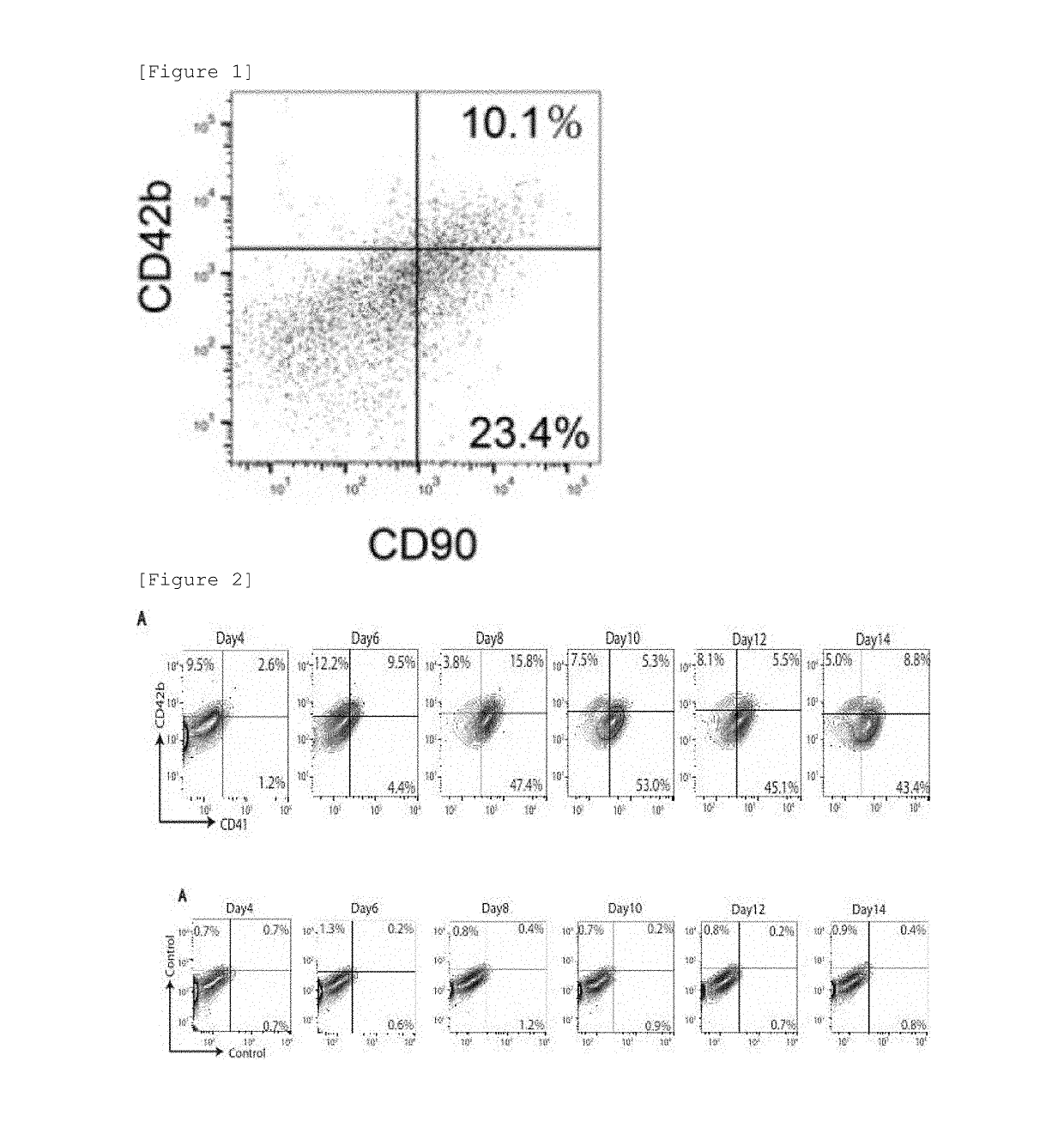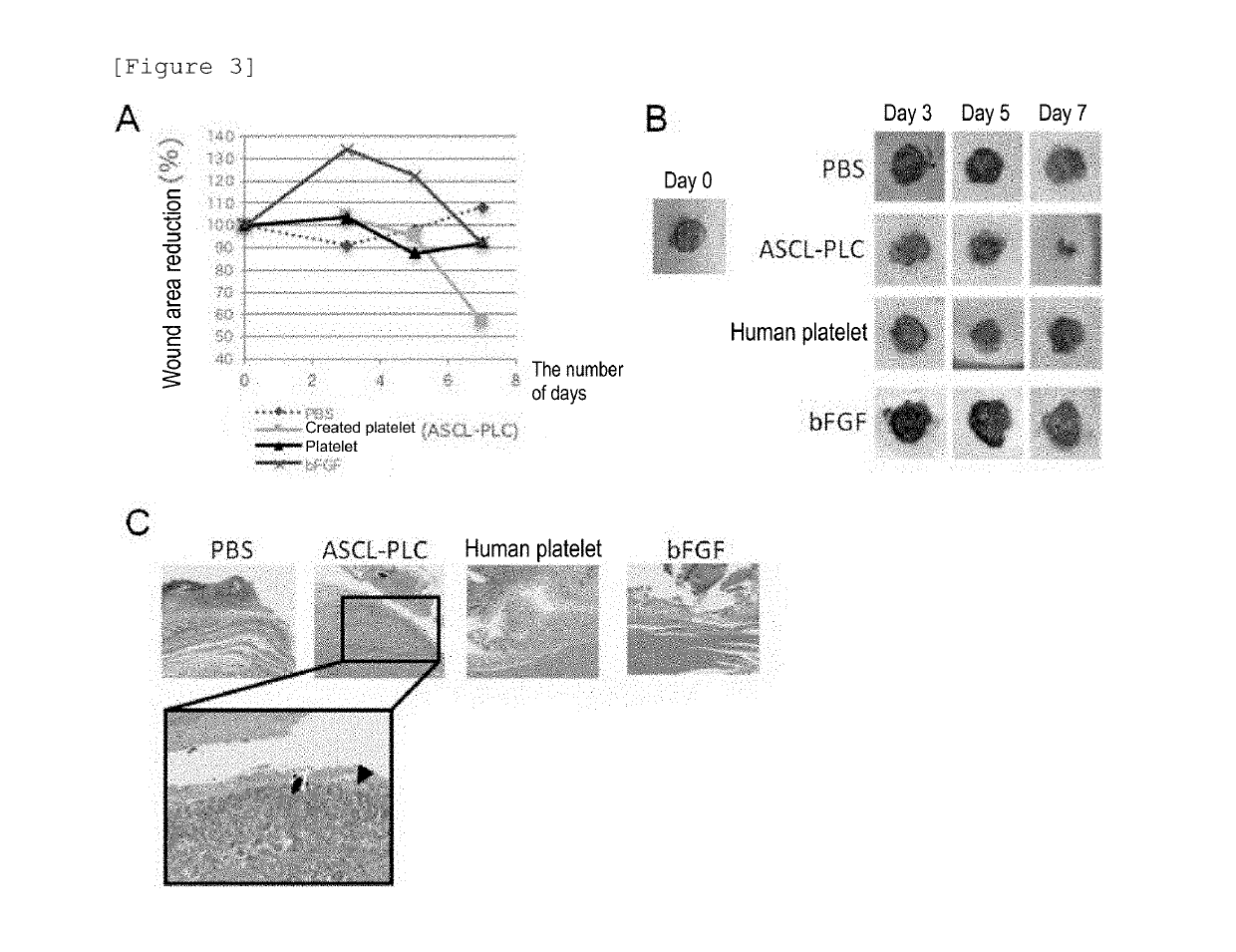Agent for promoting wound healing comprising platelet-like cell co-expressing platelet surface antigen and mesenchymal cell surface antigen
- Summary
- Abstract
- Description
- Claims
- Application Information
AI Technical Summary
Benefits of technology
Problems solved by technology
Method used
Image
Examples
example 1
[Creation of Adipose Tissue-Derived Mesenchymal Cell Line]
[0173]After isolation of a subcutaneous adipose tissue section from a human, collagenase (collagenase type II; manufactured by Sigma-Aldrich Co., LLC) was added thereto, and the mixture was incubated at 37° C. for 1 hour to obtain a cell suspension. As a result of centrifuging the cell suspension, mature adipocytes having a small specific gravity floated in a supernatant, and the other types of cells were precipitated as cell pellets. The cell pellets contained mesenchymal stem cells, preadipocytes, stromal cells (stroma cells), vascular endothelial cells, smooth muscle cells, fibroblasts, and the like. In subsequent experiments, cells of the cell pellets were used. The cells of the cell pellets mentioned above were cultured at 37° C. for 10 days under conditions involving a CO2 concentration of 5% in a medium Adipocyte Differentiation Medium (manufactured by Cell Applications, Inc.) contained in a culture dish. The cells thu...
example 2
[0176][Creation of Platelet-Like Cell Population of Present Invention from Adipose Tissue-Derived Mesenchymal Cell Line]
[0177]A medium was added to a culture dish. The medium used was a medium (“modified MKLI medium”) reformed by the present inventors from MKLI (megakaryocyte lineage induction medium) medium known as a medium capable of inducing the differentiation of hematopoietic stem cells into megakaryocytes or platelet. The modified MKLI medium was created by adding 2 mM L-glutamine (manufactured by Life Technologies Corp.), 100 U / mL penicillin-streptomycin solution (manufactured by Life Technologies Corp.), 0.5% human serum albumin (manufactured by Sigma-Aldrich Co., LLC), 200 μg / mL iron-saturated transferrin (manufactured by Sigma-Aldrich Co., LLC), 10 μg / mL insulin (manufactured by Sigma-Aldrich Co., LLC), and 20 μM monothioglycerol (manufactured by Wako Pure Chemical Industries, Ltd.) to IMDM medium (Iscove's Modified Dulbecco's Medium, manufactured by Life Technologies Cor...
example 3
[Analysis of Cell Surface Marker of Platelet-Like Cell Population—1]
[0179]The human adipose tissue-derived mesenchymal stem cell line created in Example 1 was processed by the induction of differentiation into megakaryocytic cells by the method described in Example 2. The platelet-like cell population (ASCL-PLC) was collected on 12 days after the differentiation induction and suspended in a PBS solution, followed by antigen-antibody reaction at 25° C. for 45 minutes in the presence of antibodies (see Table 1) labeled with a labeling material against 25 types of cell surface markers (CD9, CD10, CD13, CD26, CD29, CD36, CD41 / CD61, CD42b, CD44, CD49b, CD61, CD63, CD72, CD73, CD77, CD81, CD90, CD95, CD107a, CD107b, CD140b, CD147, and CD164). Then, cells positive to the 25 types of cell surface markers were analyzed using a flow cytometer (FACSVerse [manufactured by BD Biosciences]) (see Table 2). For a control, the same processing as in ASCL-PLC was performed using platelet collected fro...
PUM
 Login to view more
Login to view more Abstract
Description
Claims
Application Information
 Login to view more
Login to view more - R&D Engineer
- R&D Manager
- IP Professional
- Industry Leading Data Capabilities
- Powerful AI technology
- Patent DNA Extraction
Browse by: Latest US Patents, China's latest patents, Technical Efficacy Thesaurus, Application Domain, Technology Topic.
© 2024 PatSnap. All rights reserved.Legal|Privacy policy|Modern Slavery Act Transparency Statement|Sitemap



